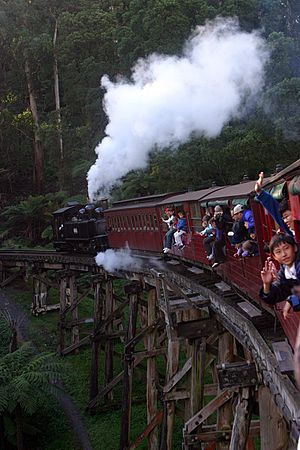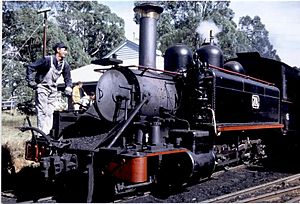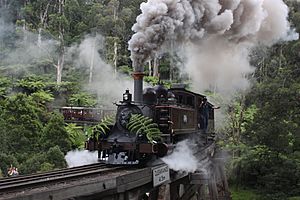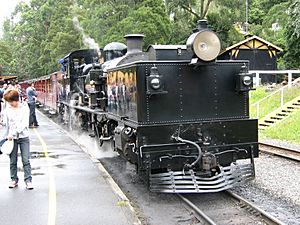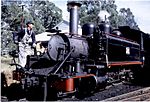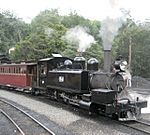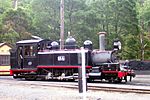Puffing Billy Railway facts for kids
Quick facts for kids Puffing Billy Railway |
|
|---|---|
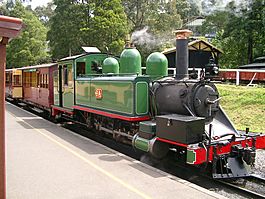
Victorian Railways NA class 6A at Belgrave station in 2002
|
|
| Overview | |
| Connecting lines | Belgrave line |
| Former connections | Upper Ferntree Gully line |
| Stations | 11 |
| Service | |
| Type | Heritage Railway |
| System | Puffing Billy Railway |
| Services | 3 to 6 services daily (except Christmas Day) |
| Rolling stock | Victorian Railways narrow gauge |
| History | |
| Commenced | 1899 |
| Opened | 1900 |
| Completed | 1900 |
| Closed | 1954 |
| Reopened | from 1962 in stages |
| Technical | |
| Line length | 25.1 km (15.6 mi) |
| Number of tracks | Single track |
| Track gauge | 2 ft 6 in (762 mm) |
The Puffing Billy Railway is a special 2 ft 6 in (762 mm) narrow gauge heritage railway located in the beautiful Dandenong Ranges near Melbourne, Australia. It was one of five narrow gauge lines built by the Victorian Railways around the early 1900s.
Today, Puffing Billy is one of the most famous steam heritage railways in the world. It attracts many visitors from Australia and other countries. The railway aims to keep the line looking and working as it did in the 1920s.
The main starting point for Puffing Billy is Belgrave station. This is where the railway's main offices and operations are located. The train journey takes you through Lakeside Station, which has a visitor centre. The end of the line is Gembrook railway station. In 2022, the railway brought back the popular tradition of passengers dangling their legs out of the open carriage windows, which is a big part of the fun!
Contents
History of Puffing Billy
Building the Line
The original railway line first opened in 1900. It was built to help local farmers and timber workers transport their goods. The line started at Upper Ferntree Gully station, which was connected to Melbourne by a wider railway line.
Over time, the railway became known by many local names, but Puffing Billy became the most popular.
Saving the Railway
In 1953, a landslide blocked the railway line. Because of this, the railway was officially closed in 1954. Many people wanted to save Puffing Billy. A teacher named Harold L. Hewett organized a meeting in 1955 to try and keep the railway running.
After the closure, some special "farewell" train rides were offered, and they were very popular. This showed how much people loved Puffing Billy.
The Preservation Society Steps In
On October 1, 1955, the Puffing Billy Preservation Society was formed. Their goal was to keep the railway running forever. They operated trains to Belgrave until 1958. Then, that part of the line was changed for modern electric trains.
The Society then started working hard to restore the section from Belgrave to Lakeside. Young volunteers, called Rover Scouts, helped clear the tracks. On July 28, 1962, trains started running again between Belgrave and Menzies Creek.
Extending the Line
Over the years, the railway was slowly extended. It reached Emerald in 1965 and Lakeside in 1975. Finally, on October 18, 1998, the line reopened all the way to Gembrook. The first trains to Gembrook carried children from local primary schools, which was a special event!
Today, Puffing Billy runs almost every day of the year (except Christmas Day). It operates between Belgrave and Lakeside, with services to Gembrook on Sundays. The railway tries to use old-fashioned practices from the early 1900s, like the "Staff and Ticket" system for safety. This helps keep the historic feel alive.
How Puffing Billy is Run
When the Puffing Billy Preservation Society first started, the railway was still owned by the Victorian Railways (V.R.). The Society arranged for the V.R. to run the trains, and the Society's volunteers helped by checking tickets and raising money.
The Emerald Tourist Railway Board
As the railway grew, the Victorian Government decided to create a special group to manage it. In 1977, they passed a law to set up the Emerald Tourist Railway Board (ETRB). This Board took over owning and running the railway from the V.R. The Puffing Billy Preservation Society continued to provide many volunteers to help.
Today, all volunteers who work on the railway are part of the ETRB. They go through training to make sure the railway runs safely and successfully. Volunteers are super important to Puffing Billy, welcoming guests from all over the world.
Many Roles to Play
Running a historic steam railway needs many different people. Volunteers work as signalmen, guards, firemen, drivers, station-masters, and more. There are also paid staff who handle management, finance, safety, and workshops.
In 2022, a new law called the Puffing Billy Railway Act 2022 was created. This new law updated how the railway is managed, especially how Board members are chosen. Volunteers are still at the heart of Puffing Billy, and the new law makes sure they continue to be registered with the Board.
Operating the Railway
Belgrave is the main hub for Puffing Billy. It has the railway's offices, workshops for the locomotives, and is the base for track maintenance.
Trains usually travel from Belgrave to Lakeside. The railway operates every day of the year, except for Christmas Day.
Legs Out the Window!
A very popular part of riding Puffing Billy is sitting on the edge of the open-sided carriages and dangling your legs out. This fun tradition was stopped for a while after a small accident in 2018. But don't worry, it was brought back permanently on February 4, 2022!
Menzies Creek Museum
At Menzies Creek station, there is a special narrow-gauge railway museum. It reopened in March 2022 after being updated. You can visit it on Fridays, Saturdays, and Sundays.
Locomotives and Carriages
Steam Locomotives
Puffing Billy owns all the remaining original Victorian Railways narrow-gauge steam locomotives. Most of them have been restored and can run. These include the 2-6-2T NA class locomotives (3A, 6A, 7A, 8A, 12A, and 14A) and the powerful G class Garratt locomotive G42.
In 2019, another large Garratt locomotive, number 129, joined the fleet. It came all the way from South Africa! The NA class engines can pull up to 10 carriages, while the bigger Garratts can pull up to 16.
Puffing Billy also has smaller steam locomotives at the Menzies Creek museum. These include a Peckett 0-4-0ST, two Decauville engines, and a Climax geared locomotive. Sometimes, these smaller engines are used for special events, like "Thomas the Tank Engine" days. You can even have a "driver experience" day on the Climax engine!
Original Victorian Railways Locomotives
Other Steam Locomotives
| Image | Number | Type | Builder | Year built | Status | Notes |
|---|---|---|---|---|---|---|
| 129 | NG/G16 2-6-2+2-6-2 |
Beyer, Peacock & Company | 1951 | Operational | A Garratt locomotive from South Africa, bought in 1996. It was rebuilt and changed to fit Puffing Billy's tracks. Started running in 2019. | |
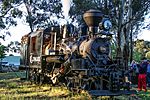 |
1694 | Climax, Two-truck |
Climax Locomotive Works | 1928 | Operational | A special geared steam locomotive, the only one of its kind built for this track size. Used to haul timber. Restored and returned to service in 2013. |
| 861 Decauville | 2-4-2ST | Couillet for Decauville | 1886 | Stored Operational | Used at the West Melbourne Gasworks. Privately owned and leased to Puffing Billy. Used for special driver experience trains. | |
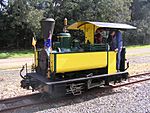 |
986 Carbon | 0-4-0T | Couillet for Decauville | 1890 | Undergoing Overhaul | Also from the West Melbourne Gasworks. A new boiler was fitted in 2013. |
| Peckett 1711 "Sir John Grice" | 0-4-0ST | Peckett & Sons | 1926 | Under Overhaul | Another engine from the West Melbourne Gasworks. Often decorated for "Thomas the Tank Engine" events. | |
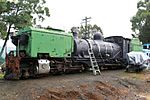 |
127 | NG G16 2-6-2+2-6-2 |
Beyer, Peacock & Company | Display | A Garratt locomotive from South Africa. It is currently on display at the Menzies Creek Museum and used for spare parts for locomotive 129. | |
| 14 Shay | Shay Two-truck |
Lima Locomotive Works | 1912 | Display | A geared locomotive from Taiwan, given as a gift in 1972. On display at the Menzies Creek Museum. | |
| 3 Sub Nigel | 0-6-0WT | Orenstein & Koppel | 1931 | Display | From a gold mining company in South Africa. On display at the Menzies Creek Museum. |
Diesel Locomotives
Puffing Billy also has three diesel locomotives. These are used when there's a high risk of bushfires (total fire ban days), for maintenance work, or if not enough steam locomotives are available.
Carriages
The most common carriages on Puffing Billy are the NBH open-sided ones. These were specially built for tourists between 1918 and 1919. More have been built since then to the same design. There are also some enclosed carriages.
Four special carriages came from the Mount Lyell Railway in Tasmania after it closed. They were changed to fit Puffing Billy's tracks and are named Mt Lyell, Double Barril, Rinadeena, and Teepookana. These are now used as first-class carriages for special lunch and dinner trains.
| Number | Image | Year built | Builder | Status | Notes |
|---|---|---|---|---|---|
| NB | 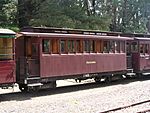 |
Goods Vehicles and Brake Vans
Puffing Billy also has examples of all the different goods wagons and brake vans that were used on the original narrow gauge lines. These are used for maintenance work, storage, and sometimes for special heritage trains that show what trains looked like in the 1920s.
Stations Along the Line
Regular Puffing Billy trains usually stop only at the stations shown in bold print on the map. You can sometimes ask to stop at other stations too.


